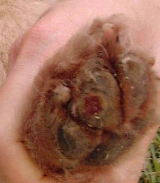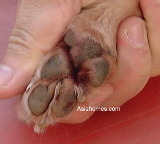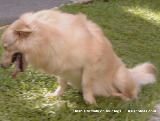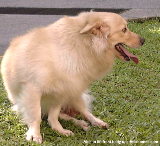| 1339Singapore
Labrador thoracolumbar quadriparesis, paralysed on four legs, disc
disease, pet health
and welfare educational for animal lovers, excerpts from The Glamorous Vets,
Singapore, sponsored by AsiaHomes Internet. The Labrador was paralysed after seeing the vet  "He had a
big cut in his foot pad
for a few days after climbing up a slope.
His left hind foot was bandaged and after taking 6 antibiotic capsules
given by the vet, he could not walk anymore. Could the medicine be the cause of his
problem since he was walking normally before seeing the vet?" asked Mrs Schwarz.
Was the other veterinarian medically negligent? "He had a
big cut in his foot pad
for a few days after climbing up a slope.
His left hind foot was bandaged and after taking 6 antibiotic capsules
given by the vet, he could not walk anymore. Could the medicine be the cause of his
problem since he was walking normally before seeing the vet?" asked Mrs Schwarz.
Was the other veterinarian medically negligent? The 3-year-old Labrador could move its four legs but could not stand up. It just paddled its front leg to move forward. Something had affected the brain area which controls movement of the four legs. Did the dog contact tetanus, a disease known to be caused by the toxins produced by the Clostridium tetani bacteria which might have entered the dog's nerves through the foot pad wound? There are reported cases of people stepping on rusty nails and then dying of tetanus. However, the dog's wound appeared superficial while the tetanus bacteria flourish in deep wounds where there is no oxygen. Once the nerves in the muscles cannot function, the muscles are paralysed, so the dog is unable to get up. Worst cases end in the dog being unable to open its mouth (locked jaws) and its head extended upwards towards the sky. However, this dog was not showing such terminal signs. What would be the other causes? The amoxycillin capsules given by the vet are not known to cause paralysis of the four legs. The condition is quadriparesis if the paralysis is temporary or quadriplegia if the paralysis was permanent. "What did the vet say about the cut in the foot pad?" I asked. "He did not say a word but just treated the dog," Mrs Schwarz replied. This was an usual to encounter a taciturn veterinarian in private practice. "Did the dog get a knock on its head or fell down from the hilly slope while its paw pad was lacerated by something sharp?" I asked. "No," Mrs Schwarz said. "I would know since I was with him." "You can't be watching him all the time," I said. "Something might have traumatised his head at home. For example, the wooden handle of the kitchen mop or a pot from the kitchen table falling on his head." The dog lived in an apartment and was free to go to the kitchen. "Did the dog run up and down the steps every day from the third floor apartment?" I asked. Mrs Schwarz said yes. There was no lift at the third floor and this meant walking down several flights of steps to go to the grass field daily. "He could have slipped while running downstairs and knocked his head on the wall or steps, causing a traumatic injury to his brain and thereby a loss of control of the four legs. " I said. "It is possible that after a few years of running up and down sixty flights of steps daily, the spinal discs of dogs with longer bodies get injured but the dog is usually paralysed on the back legs, not on all four legs." The dog was hyper sensitive to touch along its back and spinal area. As if he had pain it could not tell us. Other than the manifestation of pain, the dog was normal on examination.  The bandage was removed to review a deep
reddish cut of the foot pad. A clean raw strawberry coloured wound
showing the rich blood vessel area. Only one pad was affected.
The hard grey layer had been sliced off by something sharp. The bandage was removed to review a deep
reddish cut of the foot pad. A clean raw strawberry coloured wound
showing the rich blood vessel area. Only one pad was affected.
The hard grey layer had been sliced off by something sharp. All medication was stopped just in case the dog was adversely affected by the medicine. The dog was given multi-vitamins and a pain killer injection. An antiseptic wash was given to clean the cut pad. Mrs Schwarz was convinced that the quadriparesis was due to the medication given by the vet.  Five days later, Mrs Schwarz came, saying that the dog was biting its left
hind foot which had the cut pad. He could lift
up its front body but the back legs were still paralysed. He didn't like anybody to
touch his chest which must be painful after being dragged on the floor for so many days.
He had not passed motion for three days.
"I will sue the vet for giving the wrong medication," Mr Schwarz said.
Amoxycillin is commonly used to treat bacterial infections and has not been known
to cause this paralysis. I put him onto the examination table and
reviewed his spinal area again, pressing
hard with my thumb and forefinger onto the top of his backbone from the neck to this tail. Five days later, Mrs Schwarz came, saying that the dog was biting its left
hind foot which had the cut pad. He could lift
up its front body but the back legs were still paralysed. He didn't like anybody to
touch his chest which must be painful after being dragged on the floor for so many days.
He had not passed motion for three days.
"I will sue the vet for giving the wrong medication," Mr Schwarz said.
Amoxycillin is commonly used to treat bacterial infections and has not been known
to cause this paralysis. I put him onto the examination table and
reviewed his spinal area again, pressing
hard with my thumb and forefinger onto the top of his backbone from the neck to this tail. The Labrador turned his head angrily as if to say "stop it, you're
hurting me" but did not bite when I pressed on
the middle of his spinal area, behind his last rib, the thirteenth
rib. This area is called the thoracic-lumbar area of the intervertebral
disc. He turned his head again when I pressed the same
location. Otherwise, there was no response from him.
The Labrador turned his head angrily as if to say "stop it, you're
hurting me" but did not bite when I pressed on
the middle of his spinal area, behind his last rib, the thirteenth
rib. This area is called the thoracic-lumbar area of the intervertebral
disc. He turned his head again when I pressed the same
location. Otherwise, there was no response from him.
I pressed the skin between his paws of all four legs. Not much response as he had a pain killer injection . He did move his feet away.  The dog was put on the grass patch. He wanted to stand up but could not do so.
The dog was put on the grass patch. He wanted to stand up but could not do so.
He passed a small piece of stools indicating that he had control of his rectum. He did pass urine voluntarily which is a good sign that the bladder was not paralysed. "There are many causes of paralysis," I said. "Most likely this dog's head had been knocked by some objects, for example in the kitchen." The kitchen was rather small for a big dog. Mrs Schwarz recalled one episode of something fall on his head. The cut pad wound was healing well. The dog seemed to be regaining its leg's motor movement and could pass water and move its bowels. These were good signs and the dog has a good chance of recovery of being able to walk on all four legs if he could be confined for the next few weeks. "It would take at least a month of rest for the dog to recover. He must be confined to a small space and not allowed to run around." I said. "He had a head injury as earlier but his main injury is the thoracolumbar disc disease, causing the spinal cord pain at the vertebra numbered T13/L1. The pain in disc disease is due to the spasm the muscles near the lesion. Irritation of the vertebral nerve root and oedema of the spinal cord cause more pain." What was the degree of nerve damage in this dog and what are chances of recovery?  Using
a 4-grade system (1 = pain only; 2 = pain + paresis; 3 = pain + paralysis; 4 = paralysis
of both hind limbs and loss of deep pain sensation, meaning constipation
and unable to pass urine), the chances of recovery in grade 1 and 2 is
excellent; in grade 3 is very good and in grade 4 is poor. Grade 4 cases need a lot of care (nursing,
turning frequently to prevent body sores, catheterisation, manual emptying of rectum in
constipation). Many owners are unable to nurse a dog suffering with
grade 4 symptoms. Using
a 4-grade system (1 = pain only; 2 = pain + paresis; 3 = pain + paralysis; 4 = paralysis
of both hind limbs and loss of deep pain sensation, meaning constipation
and unable to pass urine), the chances of recovery in grade 1 and 2 is
excellent; in grade 3 is very good and in grade 4 is poor. Grade 4 cases need a lot of care (nursing,
turning frequently to prevent body sores, catheterisation, manual emptying of rectum in
constipation). Many owners are unable to nurse a dog suffering with
grade 4 symptoms.This dog had grade 2 since he was not really paralysed and could now lift his front body. He should be able to recover within 3 months. The treatment is to confine it and restrict its movement. How to confine an athletic dog to a small area? People with disc lesions understand the reasons for being immobilised to encourage recovery but how do you reason with an active canine patient? |